cruise control KIA NIRO HYBRID EV 2022 Owners Manual
[x] Cancel search | Manufacturer: KIA, Model Year: 2022, Model line: NIRO HYBRID EV, Model: KIA NIRO HYBRID EV 2022Pages: 684, PDF Size: 9.67 MB
Page 218 of 684
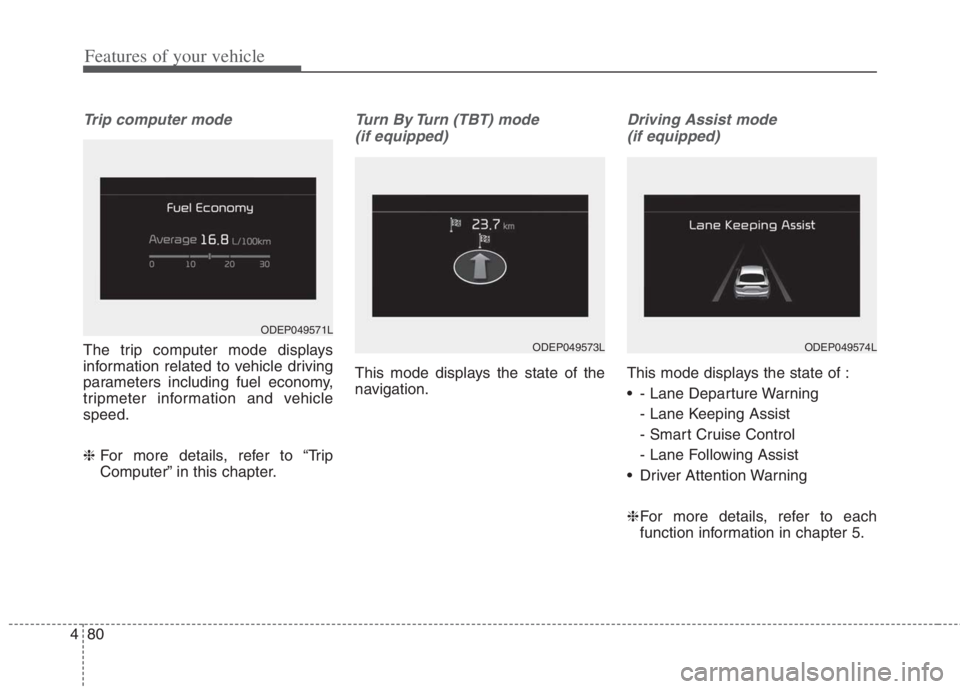
Features of your vehicle
80 4
Trip computer mode
The trip computer mode displays
information related to vehicle driving
parameters including fuel economy,
tripmeter information and vehicle
speed.
❈ For more details, refer to “Trip
Computer” in this chapter.
Turn By Turn (TBT) mode
(if equipped)
This mode displays the state of the
navigation.
Driving Assist mode
(if equipped)
This mode displays the state of :
- Lane Departure Warning
- Lane Keeping Assist
- Smart Cruise Control
- Lane Following Assist
Driver Attention Warning
❈For more details, refer to each
function information in chapter 5.
ODEP049571L
ODEP049574LODEP049573L
Page 219 of 684

481
Features of your vehicle
Tire Pressure
❈For more details, refer to “Tire
Pressure Monitoring System
(TPMS)” in chapter 6.Master warning mode
This warning light informs the driver
the following situations.
Forward Collision-Avoidance Assist
malfunction (if equipped)
Forward Collision-Avoidance Assist
radar blocked (if equipped)
Blind-Spot Collision Warning mal-
function (if equipped)
Blind-Spot Collision Warning radar
blocked (if equipped)
Lamp malfunction
LED headlamp malfunction (if
equipped) High Beam Assist malfunction (if
equipped)
Tire Pressure Monitoring System
(TPMS) malfunction
Smart Cruise Control malfunction (if
equipped)
Smart Cruise Control radar blocked
(if equipped)
Lane Following Assist malfunction (if
equipped), etc.
At this time, a Master Warning icon
( ) will appear beside the User
Settings icon ( ), on the LCD display.
If the warning situation is solved, the
master warning light will be turned
off and the Master Warning icon will
disappear.
ODEP049575L
Page 221 of 684
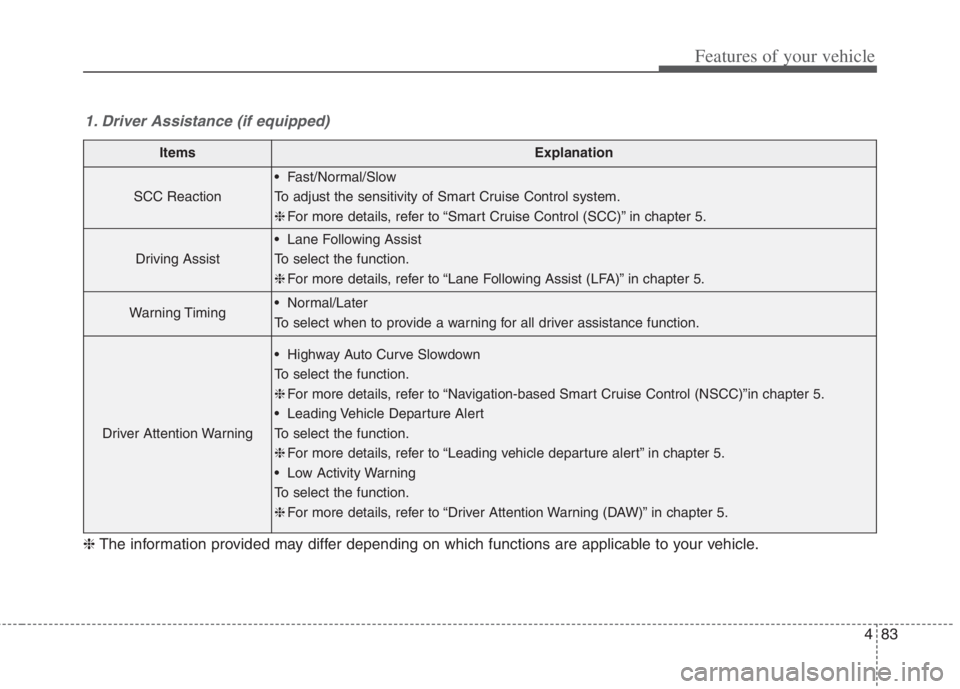
483
Features of your vehicle
1. Driver Assistance (if equipped)
ItemsExplanation
SCC Reaction
Fast/Normal/Slow
To adjust the sensitivity of Smart Cruise Control system.
❈For more details, refer to “Smart Cruise Control (SCC)” in chapter 5.
Driving Assist
Lane Following Assist
To select the function.
❈For more details, refer to “Lane Following Assist (LFA)” in chapter 5.
Warning Timing Normal/Later
To select when to provide a warning for all driver assistance function.
Driver Attention Warning
Highway Auto Curve Slowdown
To select the function.
❈For more details, refer to “Navigation-based Smart Cruise Control (NSCC)”in chapter 5.
Leading Vehicle Departure Alert
To select the function.
❈For more details, refer to “Leading vehicle departure alert” in chapter 5.
Low Activity Warning
To select the function.
❈For more details, refer to “Driver Attention Warning (DAW)” in chapter 5.
❈The information provided may differ depending on which functions are applicable to your vehicle.
Page 252 of 684

Features of your vehicle
114 4
Master Warning light
(if equipped)
This warning light informs the driv-
er the following situations.
- Forward Collision-Avoidance Assist
malfunction (if equipped)
- Forward Collision-Avoidance Assist
radar blocked (if equipped)
- Blind-Spot Collision Warning mal-
function (if equipped)
- Blind-Spot Collision Warning radar
blocked (if equipped)
- Lamp malfunction
- LED headlamp malfunction (if
equipped)
- High Beam Assist malfunction (if
equipped)
- Tire Pressure Monitoring System
(TPMS) malfunction
- Smart Cruise Control malfunction (if
equipped)
- Smart Cruise Control radar blocked
(if equipped)
- Lane Following Assist malfunction (if
equipped), etc.The Master Warning Light illuminates
when one or more of the above warn-
ing situations occur. If the warning situ-
ation is resolved, the master warning
light will turn off.
Engine Coolant
Temperature Warning
Light
This warning light illuminates:
When the engine coolant tempera-
ture is above 120°C (248°F). This
means that the engine is overheat-
ed and may be damaged.
If your vehicle is overheated, refer
to “If the engine overheats” in
chapter 6.
CAUTION - Engine
Overheating
Do not continue driving with the
engine overheated. Otherwise
the engine may be damaged.
Page 329 of 684
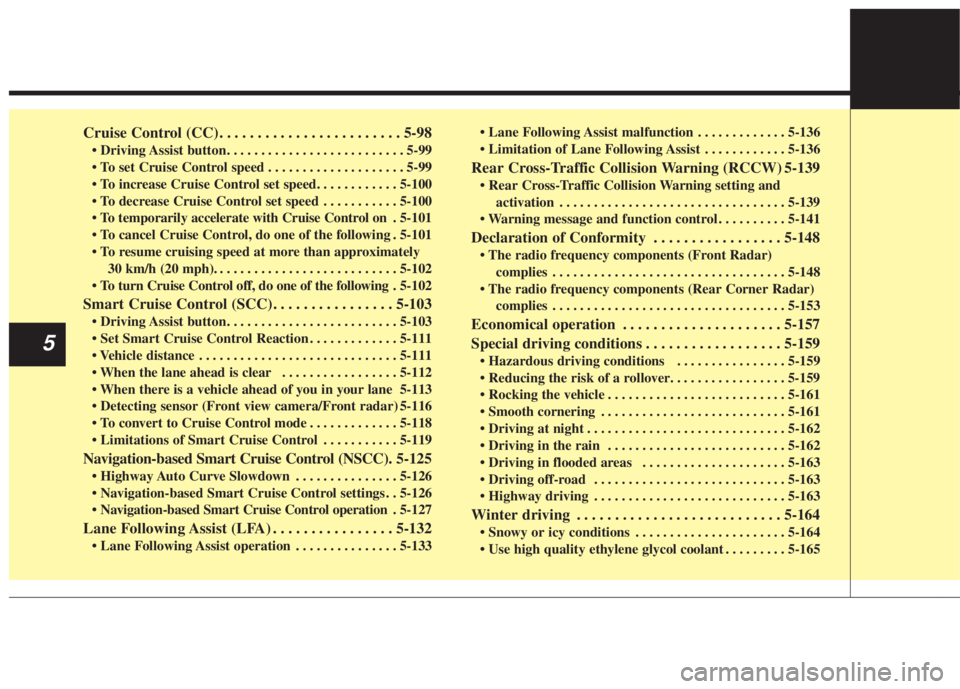
Cruise Control (CC). . . . . . . . . . . . . . . . . . . . . . . . 5-98
. . . . . . . . . . . . . . . . . . . . 5-99
. . . . . . . . . . . 5-100
. 5-101
do one of the following . 5-101
30 km/h (20 mph). . . . . . . . . . . . . . . . . . . . . . . . . . . 5-102
do one of the following . 5-102
Smart Cruise Control (SCC). . . . . . . . . . . . . . . . 5-103
. . . . . . . . . . . . . 5-111
. . . . . . . . . . . . . . . . . . . . . . . . . . . . . 5-111
. . . . . . . . . . . . . . . . . 5-112
5-113
5-116
. . . . . . . . . . . . . 5-118
. . . . . . . . . . . 5-119
Navigation-based Smart Cruise Control (NSCC). 5-125
. . . . . . . . . . . . . . . 5-126
. . 5-126
. 5-127
Lane Following Assist (LFA) . . . . . . . . . . . . . . . . 5-132
. . . . . . . . . . . . . . . 5-133 . . . . . . . . . . . . . 5-136
. . . . . . . . . . . . 5-136
Rear Cross-Traffic Collision Warning (RCCW) 5-139
activation . . . . . . . . . . . . . . . . . . . . . . . . . . . . . . . . . 5-139
. . . . . . . . . . 5-141
Declaration of Conformity . . . . . . . . . . . . . . . . . 5-148
complies . . . . . . . . . . . . . . . . . . . . . . . . . . . . . . . . . . 5-14\
8
complies . . . . . . . . . . . . . . . . . . . . . . . . . . . . . . . . . . 5-15\
3
Economical operation . . . . . . . . . . . . . . . . . . . . . 5-157
Special driving conditions . . . . . . . . . . . . . . . . . . 5-159
. . . . . . . . . . . . . . . . 5-159
. . . . . . . . . . . . . . . . . . . . . . . . . . 5-161
. . . . . . . . . . . . . . . . . . . . . . . . . . . 5-161
. . . . . . . . . . . . . . . . . . . . . . . . . . . . . 5-162
. . . . . . . . . . . . . . . . . . . . . . . . . . 5-162
. . . . . . . . . . . . . . . . . . . . . 5-163
. . . . . . . . . . . . . . . . . . . . . . . . . . . . 5-163
. . . . . . . . . . . . . . . . . . . . . . . . . . . . 5-163
Winter driving . . . . . . . . . . . . . . . . . . . . . . . . . . . 5-164
. . . . . . . . . . . . . . . . . . . . . . 5-164
. . . . . . . . . 5-165
5
Page 355 of 684
![KIA NIRO HYBRID EV 2022 Owners Manual Driving your vehicle
28 5
Regenerative Braking
(Paddle Shifter)
The paddle shifter is used to adjust
the regenerative braking level from 0
to 3 during decelerating or braking.
Left side [-] : Increa KIA NIRO HYBRID EV 2022 Owners Manual Driving your vehicle
28 5
Regenerative Braking
(Paddle Shifter)
The paddle shifter is used to adjust
the regenerative braking level from 0
to 3 during decelerating or braking.
Left side [-] : Increa](/img/2/58909/w960_58909-354.png)
Driving your vehicle
28 5
Regenerative Braking
(Paddle Shifter)
The paddle shifter is used to adjust
the regenerative braking level from 0
to 3 during decelerating or braking.
Left side [-] : Increases regenera-
tive braking and deceleration.
Right side [+] : Decreases regener-
ative braking and deceleration.
✽ ✽
NOTICE
• The control level will be started at
0 when the engine start. It will
activate only in D (Drive) range.
• If you operate the shift lever (to P,
R, N/Sport), Regen B mode will be
cancelled and if you return to D
(Drive) range, the Regen B mode
will be returned to 0 level.
• Regen B mode will be cancelled
when ABS, ESC operate.
• The speed decrement may differ-
ent depends on the vehicle speed
even in the same Regen B level.
(The speed decrement in each level
is bigger in the city driving than
that of highway driving.)
✽ ✽
NOTICE
The vehicle does not completely stop
by using paddle shifter lever. When
the Regen B power reduced, the
vehicle slowly moves about 10 km/h.
In order to stop the vehicle, depress
the brake pedal.
✽ ✽
NOTICE
The paddle shifter does not operate
when:
• The [-] and [+] paddle shifters are
pulled at the same time.
• The vehicle is decelerating by
depressing the brake pedal.
• Cruise Control system or Cruise
Control system is activated.
REGENERATIVE BRAKING SYSTEM
ODEP051294L
WARNING
Usage of the regenerative brak-
ing function may be limited
according to the battery and
motor’s condition. (over charge,
high and low temperature)
Check traffic and driving condi-
tions. If necessary, control the
vehicle speed by using the
brake pedal.
Page 357 of 684

Driving your vehicle
30 5
Regeneration unavailable. Battery
full
If SOC(State of High voltage battery
Charge) is high, it is not possible to
enable Regen B mode. Use the func-
tion again after normal driving.
Regeneration conditions not met
If the motor and battery is in
high/low temperature status or if
there is a malfunction on battery
and transmission, the warning
message will be displayed.
If the vehicle entering the Regen B
mode during the activation of
ABS/Cruise Control/Smart Cruise
Control, the warning message will
be displayed.
Once the warning message is dis-
played, the usage of function will be
temporarily limited. Use the function
again after normal driving.
ODEP059296L
ODEP059295L
Page 425 of 684
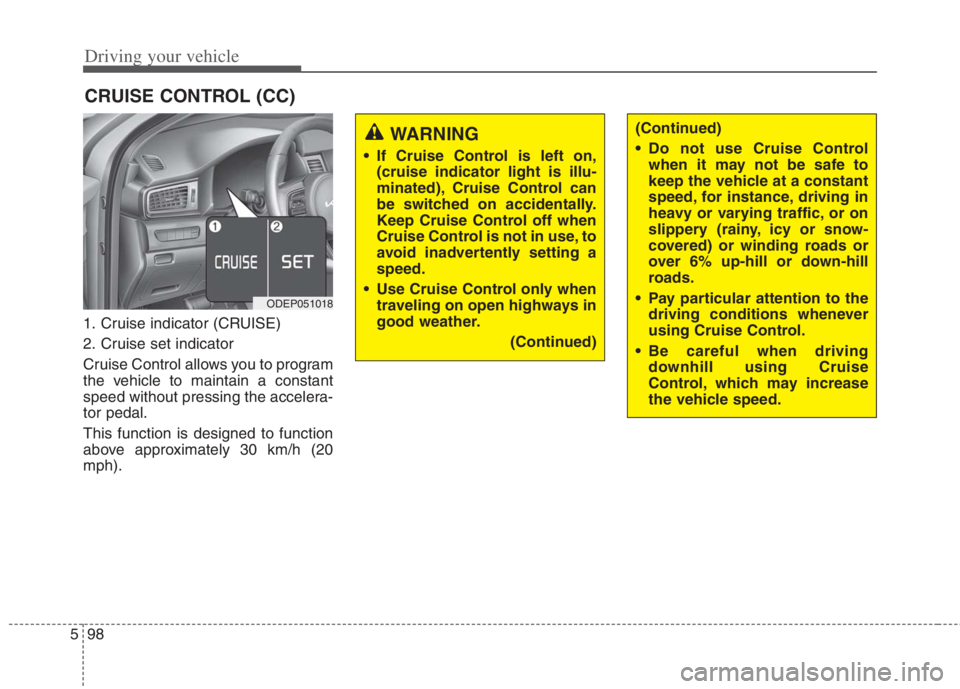
Driving your vehicle
98
5
1. Cruise indicator (CRUISE)
2. Cruise set indicator
Cruise Control allows you to program
the vehicle to maintain a constant
speed without pressing the accelera-
tor pedal.
This function is designed to function
above approximately 30 km/h (20
mph).
CRUISE CONTROL (CC)
WARNING
• If Cruise Control is left on,
(cruise indicator light is illu-
minated), Cruise Control can
be switched on accidentally.
Keep Cruise Control off when
Cruise Control is not in use, to
avoid inadvertently setting a
speed.
Use Cruise Control only when traveling on open highways in
good weather.
(Continued)
(Continued)
Do not use Cruise Controlwhen it may not be safe to
keep the vehicle at a constant
speed, for instance, driving in
heavy or varying traffic, or on
slippery (rainy, icy or snow-
covered) or winding roads or
over 6% up-hill or down-hill
roads.
Pay particular attention to the driving conditions whenever
using Cruise Control.
Be careful when driving downhill using Cruise
Control, which may increase
the vehicle speed.
ODEP051018
Page 426 of 684
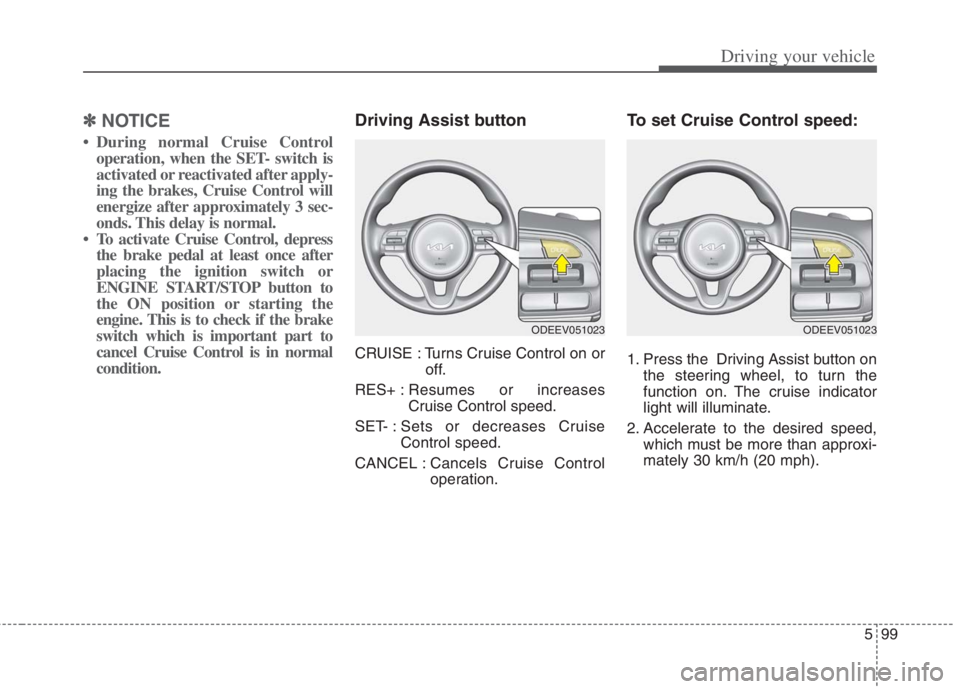
599
Driving your vehicle
✽ ✽
NOTICE
• During normal Cruise Control
operation, when the SET- switch is
activated or reactivated after apply-
ing the brakes, Cruise Control will
energize after approximately 3 sec-
onds. This delay is normal.
• To activate Cruise Control, depress
the brake pedal at least once after
placing the ignition switch or
ENGINE START/STOP button to
the ON position or starting the
engine. This is to check if the brake
switch which is important part to
cancel Cruise Control is in normal
condition.
Driving Assist button
CRUISE : Turns Cruise Control on or
off.
RES+ :Resumes or increases
Cruise Control speed.
SET- : Sets or decreases Cruise
Control speed.
CANCEL :Cancels Cruise Control
operation.
To set Cruise Control speed:
1. Press the Driving Assist button on
the steering wheel, to turn the
function on. The cruise indicator
light will illuminate.
2. Accelerate to the desired speed,
which must be more than approxi-
mately 30 km/h (20 mph).
ODEEV051023ODEEV051023
Page 427 of 684
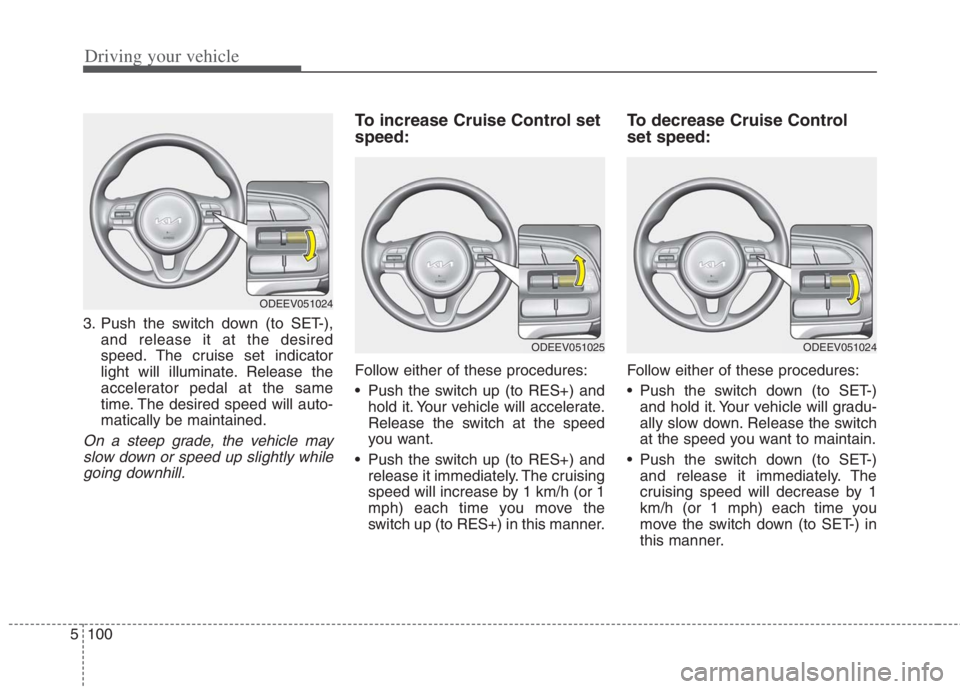
Driving your vehicle
100
5
3. Push the switch down (to SET-),
and release it at the desired
speed. The cruise set indicator
light will illuminate. Release the
accelerator pedal at the same
time. The desired speed will auto-
matically be maintained.
On a steep grade, the vehicle mayslow down or speed up slightly whilegoing downhill.
To increase Cruise Control set
speed:
Follow either of these procedures:
Push the switch up (to RES+) and hold it. Your vehicle will accelerate.
Release the switch at the speed
you want.
Push the switch up (to RES+) and release it immediately. The cruising
speed will increase by 1 km/h (or 1
mph) each time you move the
switch up (to RES+) in this manner.
To decrease Cruise Control
set speed:
Follow either of these procedures:
Push the switch down (to SET-)and hold it. Your vehicle will gradu-
ally slow down. Release the switch
at the speed you want to maintain.
Push the switch down (to SET-) and release it immediately. The
cruising speed will decrease by 1
km/h (or 1 mph) each time you
move the switch down (to SET-) in
this manner.
ODEEV051024
ODEEV051025ODEEV051024